The Durable Goods, advance report shows new orders shot up by 2.0% in July. June showed a whopping 4.1% new orders increase. Core capital goods, showed a 2.2% monthly gain. Without transportation new orders, which includes aircraft, durable goods new orders would have increased by 0.6%. Motor vehicles & parts new orders gained 4.0% for the month.
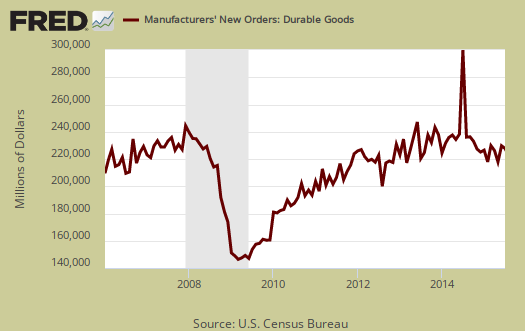
Below is a graph of all transportation equipment new orders, which increased by 4.7% for the month. Nondefense aircraft & parts new orders dropped by -6.0%. Aircraft & parts from the defense sector decreased by -13.1%. Aircraft orders are notoriously volatile, each order is worth millions if not billions, and as a result aircraft manufacturing can skew durable goods new orders on a monthly comparison basis.
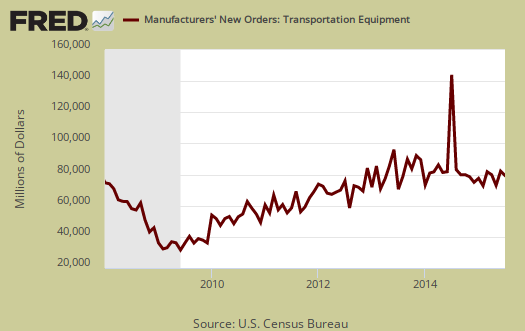
Core capital goods new orders increased by 2.2%. June's core capital goods new orders increased by 1.4%. Core capital goods is an investment gauge for the bet the private sector is placing on America's future economic growth and excludes aircraft & parts and defense capital goods. Capital goods are things like machinery for factories, measurement equipment, truck fleets, computers and so on. Capital goods are the investment types of products one needs to run a business. and often big ticket items. A decline in new orders indicates businesses are not reinvesting in themselves. This month machinery new orders increased by 1.5%, while computers & electronics increased by 2.0% and primary metals decreased -1.8%.
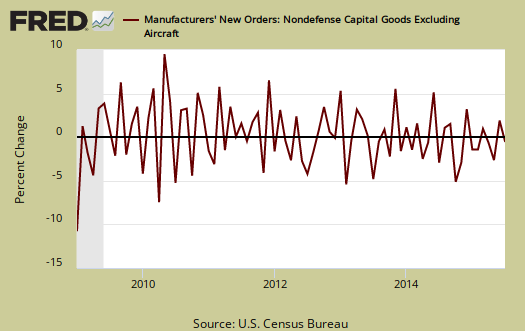
To put the monthly percentage change in perspective, below is the graph of core capital goods new orders, monthly percentage change going back to 2008. Looks like noise, even during the great recession, which tells us the monthly percentage changes in this report really need to be taken with a grain of salt and one should think quarterly. It maybe an early indicator, or simply a false alarm as these figures are nearly always revised in the more complete factory order report.
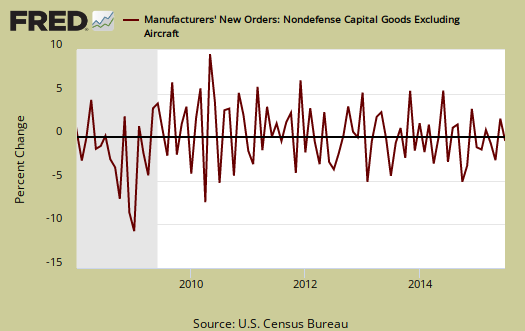
Shipments increased by 1.0% after a June 0.9% increase. New orders are not necessarily shipped the next month an order is made. Below is the monthly shipments; percent change for all durable goods shipments.
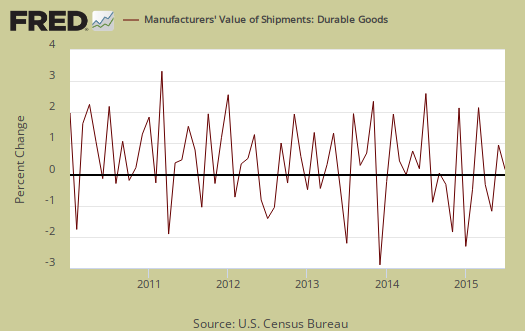
Shipments in core capital goods increased 0.6%. The below graph goes back to 1990 to show how core capital goods shipments tracks recessions, the gray bars in the graph.
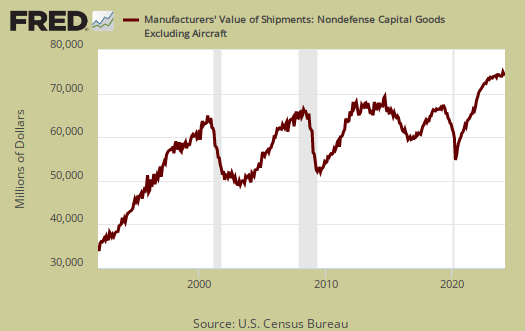
Inventories, which also contributes to GDP, had no change. June showed 0.4% gain. It is too early to see what this implies for Q3 GDP.
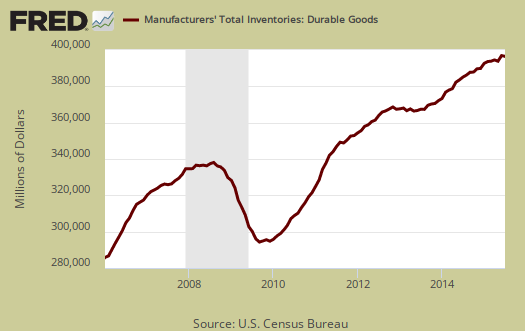
Core Capital Goods inventories decreased -0.1% for the month. Graphed below are monthly core capital goods inventories annualized percentage change and pay close attention to the months of Q1, against the Q2 months. It is too early to see what Q3 is shaping out to be.
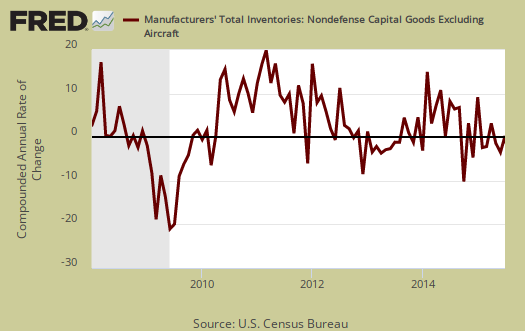
Core shipments contributes to the investment component of GDP. Producer's Durable Equipment (PDE) is part of the GDP investment metric, the I in GDP or nonresidential fixed investment. It is not all, but part of the total investment categories for GDP, usually contributing about 50% to the total investment metric (except recently where inventories have been the dominant factor). Producer's Durable Equipment (PDE) is about 75%, or 3/4th of the durable goods core capital goods shipments, in real dollars, used as an approximation. Below is the national accounts description of PDE:
Nonresidential PDE consists of private business purchases on capital account of new machinery, equipment such as furniture, and vehicles (except for personal-use portions of equipment purchased for both business and personal use, which are included in PCE), dealers' margins on sales of used equipment, and net purchases of used equipment from government agencies, from persons, and from the rest of the world.
The below graph might give a feel for what kind of investment component we might see in Q2 GDP revisions, based on PDE. Note the below is the annualized monthly percentage change of nominal values, not real, not adjusted for inflation, for core capital goods shipments.
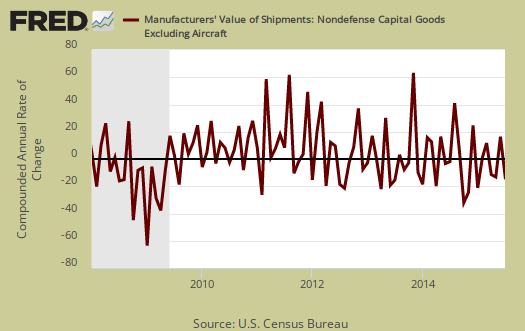
This month's report indicates there is healthy growth durable goods. Not spectacular growth but very solid. The reality is China represents imports to the United States, as well as multinational corporate profits from offshore outsourcing manufacturing. Yet this report is ignored by Wall Street while Central Banks zero percent interest rates only catch their eye.
What is a durable good? It's stuff manufactured that's supposed to last at least 3 years. Here are our durable goods, related overviews, only some graphs revised. The durable goods advance report is often revised when the full factory orders statistics are released. The report excludes semiconductor manufacturing and we must wonder if that means it is non-existent since so much has been offshore outsourced and thus corporations don't want the public to figure that fact out.

orders for transportation equipment don't add up
maybe i'm missing something, but new orders for transportation equipment don't add up...cars and parts, up 4.0%, commercial aircraft down 6%, defense aircraft down 13.1%, and the total of those is up 4.7%?
i also added the dollar amount and they came up way short: http://www.census.gov/manufacturing/m3/adv/pdf/durgd.pdf
see if you can figure out what i might have missed...
rjs
volume, total dollar amounts
That is just percentage change against itself in category. I don't have the solid figures but assume autos durable goods sales are $80 billion for the month but airplanes would be say $10 billion or so. The overall change would be impacted most by auto sales since by volume and dollar amounts, they are most of transportation sales on a monthly basis.
the numbers, as listed
vehicle & parts orders were $53,253 million, up 4.0% from $51,226 mllion, nondefense aircraft and parts wee a $16,507 million, down 6.0% from $17,556 million, and defense aircraft and parts were at $4,415 million, down 13.1% from $5,081 millon....that does not add up to the total transportation equipment new orders of $83,231 million, up 4.7% from $79,476 million..
best i can figure is that they're including a big military vehilcle order in here that they don't show in the totals above...
rjs
ships and boats
according to the full factory orders report, new orders for ships and boats were up 19.5%, which lifted new transport orders to a 5.0% increase...they weren't listed in the advance report, leading to my confusion on the numbers that were listed..
rjs
durable goods 2.2% vs. 2.0%
I hate covering the advance report for it's always revised. Why does Wall Street jump on this when they know it won't hold?